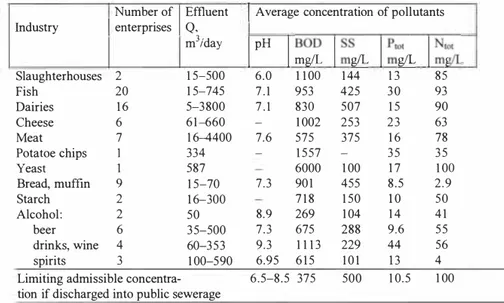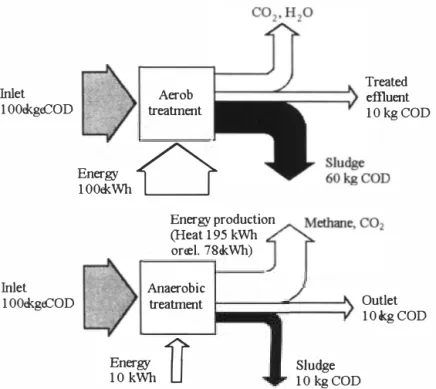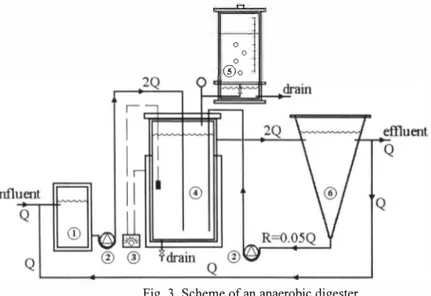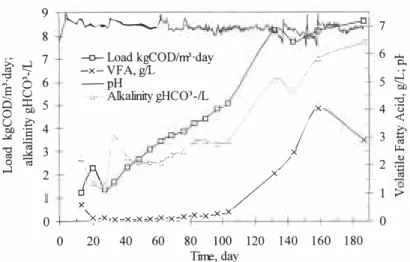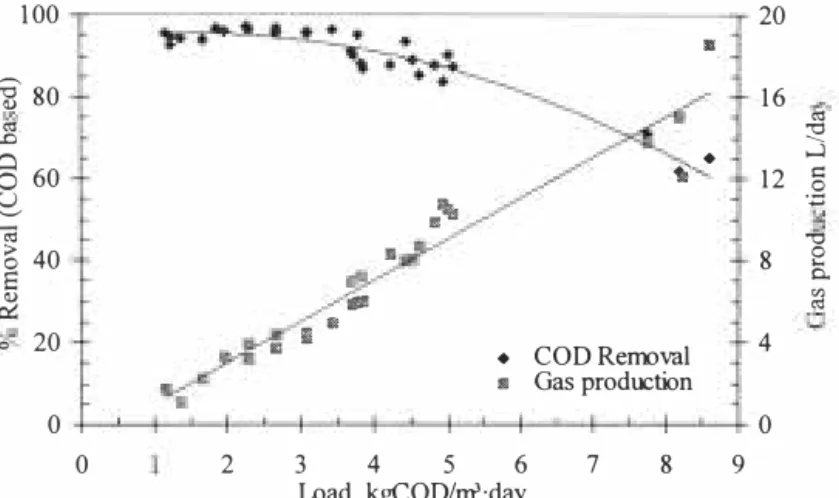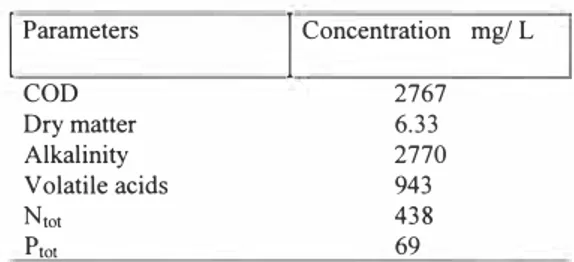32
ANAEROBIC TECHNOLOGY FOR
TREATMENTOF CONCENTRATED
WASTEWATER FROM ESTONIAN
FOOD INDUSTRIES
H.MOLDER
VBLONSKA YA
Tallinn Technical University, Estonia
ABSTRACT
Anaerobic wastewater treatment technologies are used throughout the world for effective treatment of a wide variety of industrial wastewater, in particular for the wastewater from the food industry. This type of wastewater is rich in easily biodegradable carbohydrates and has a relatively low content in suspended solids. As an example, the anaerobic bio-degradation of organic matter in wastewater ( cheese whey ) was studied on a laboratory - scale Upflow Anaerobic Sludge Blanket Reactor (UASB). This wastewater was found characterized by high COD concentration, from 58.000 to 72.000 mg/L. The digester efficiency during the treatment process of cheese wastewater at various organic loading rates (0.5 -16 kg COD/m3 • day ) was studied and its performance was assessed by monitoring the p value ( 6.8 -7.3 ) and biogas production ( up to 24 L /day ). H The investigation has demonstrated that the process of anaerobic degradation was sufficiently effective for COD removal.
KEYWORDS
Food industry; cheese whey; biodegradable organic; anaerobic treatment; UASB-reactor. INTRODUCTION
The food industry is one of the major contributors of wastewater pollution. Estonia has 70 small enterprises of the food industry, some of them have very small flow rates ( some m3 per day ). Today (1999) some of enterprises are pumping their wastewater to the wastewater treatment plants of towns and others have local treatment plants. In many cases the local treatment plants are rather old and work inefficiently. The quality of wastewater varies according to the branch of industry and mill type, but all wastewater from food industries
Heino MOider, Estonia 283
-
-93 334
7.3 455
ECOLOGICAL TECHNOLOGY AND MANAGEMENT KALMAR, SWEDEN, September 22-24, 1 999
contains an organic matter which is easily biodegradable. Most of effluents are also rich in phosphorus and nitrogen, mostly originating from raw materials or products, but some also from washing. As seen from Table l , pollutant concentrations in municipal wastewater discharge are substantially higher of the limiting permissible concentrations, especially BOD7
and phosphorus. The average wastewater concentrations are: BOD7 - 1 1 77 mg IL, SS -261
mg /L, phosphorus -19,1 mg IL, nitrogen - 57,9 mg/ L and ratio BOD : N : P is 1 00 : 4,9 : 1 ,6. TABLE I The characteristics of the food industry effluent
Number of Effluent I
I
Average concentration of pollutantsI
Q, Industry enterprises g/L g/LI
I
I
2 1 5-500 6.0I
1 1 00 144 1 3 85 m3/day p H m�L!
l Slaughterhouses Fish 20 1 5-745 7.1 953 425 30 Dairies 16 5-3800 7.1 830 507 1 5 90 Cheese 6 61-660-
1 002 253 23 63 Meat 7 1 6-4400 7.6 575 375 1 6 78 I 1 557 35 35 Potatoe chips Yeast I 587 6000 1 00 1 7 1 00 9 1 5-70 901 8.5 2.9 Bread, muffin Starch 2 1 6-300 7 1 8 1 50 1 0 50 Alcohol: 2 50 8.9 269 1 04 1 4 41 beer 6 35-500 7.3 675 288 9.6 55 drinks, wine 4 60-353 9.3 1 1 1 3 229 44 56 spirits 3 1 00-590 6.95 615 101 13 4 Limiting admissible concentra- 6.5-8.5 375 500 1 0.5 1 00 tion if discharged into public sewerageThe temperature of wastewater is higher than that of municipal waters. Wastewater from the food industry contains proteins, fats, lactose, etc. Full utilization of all wastes on spot and their reuse at the manufactures are naturally the best method for most food industry enterprises. But these technologies are rather complicated and expensive for use in small enterprises. A biological wastes treatment may be a good alternative in such cases. In Estonia, in the majority of cases aerobic processes are used for municipal and industrial wastewater treatment. However, the wastes of food industries are categorized as medium strength organic wastewater, requiring an intensive amount of energy for aeration. Besides, a large amount of waste sludge is generated from these aerobic processes. On the other hand, anaerobic treatment technologies are used throughout the world for the effective treatment of a wide variety of industrial wastewater. The main advantages of the anaerobic treatment are ( Malina, 1992): low production of biological sludge, high treatment efficiency, low capital cost, no oxygen requirement, methane production ( potential source of fuel), low nutrient requirement, low operating cost.
Treated
Inlet Aerob effluent
l 00ekgeCOD treatment I O kg COD
Energy � l 00ekWh � Energy production (Heat 1 95 kWh oreel. 78ekWh) Inlet Anaerobic
l 00ekgeCOD treatment Outlet
l 0 ekg COD Energy
1 0 kWh
7r
U
Sludge 1 0 kg COD Fig. I. The comparison of an anaerobic and aerobic processesFigure 2 summarizes the many anaerobic designs that are currently in use for full-scale treatment applications ( Sutton, 1990 ).
Anaerobic Treatment Technologies
Suspended Growth Supported Growth
Fixed Bed Expanded/Fludized Complete Mix Anaerobic
Process Bed Process
Hybrid
Digester Contact
Upflow Anaerobic Anaerobic Lagoons Upflow Sludge
Sludge Blanket Blanket lixed Bed Reactor
Fig. 2. Commonly used full-scale anaerobic treatment processes.
Table 2 summarizes the main parameters of the anaerobic treatment processes in the wastewater of the food industry (Hanging,1996; Kalyuzhnyi,1991, 1997; Lettinga et. al. 1997; Seyfried, 1997).
Effect
97 ECOLOGICAL TECHNOLOGY AND MANAGEMENT
KALMAR, SWEDEN, September 22-24, 1999 TABLE 2 Main parameters of the anaerobic treatment processes in the
wastewater of the food industry
Industry
I
Type of the Wastewater Load, HRT,reactor concentration, mg kg COD Day of
treat-COD/L
�
ment, % Beer UASB 1300-4600 45000 1.4-14.9 5.6-9 75-80 Starch H 4500 4 228 AF 10000 10.8 10 80 UASB 8000 15 18 90-95 Potatoes AF 7500 8 24-26 80-93 H 28000 11.6 16.3 70 Dairies FB 1600 7 24 80 H 3000-33000 2 20 70 UASB 3200 12 65 85 Cheese FB 40000-70000 22 2.4 70 AF 3600 8-15.6 96-120 82-85 H UASB 3000--4500 216 3.5-15 85 6-8.2 90 92-95 UASB - Upflow Anaerobic Sludge BlanketH - Hybrid AF - Anaerobic Filter FB - Fixed Bed Processes
The best step is the local wastewater treated with the UASB process. The UASB process is the most economical system and may be used for various types of wastewater from the food industry. Advantages of this type of reactor are: to provide a polishing effect to the effluent, start-up time of reactor is short, well-established anaerobic treatment systems, to prevent the washout of viable bacterial matter. This type of reactor is characterized by the highly flocculated, well settling, compact methano-genic sludge granular, resulting in a very high biomass content (Gavala, 1998).
MATERIALS and METHODS
Milk processing is the largest sector of the food industry in Estonia, and therefore it was necessary to search an environmental friendly solution for its wastes. Anaerobic treatment of highly concentrated waste of the cheese industry was studied at the laboratory pilot-plant. The experi-mental pilot plant consisted of five-litre volume packed bed reactors, a sedimentation tank, a feed tank, and a gas collection tank (Figure 3). Temperature was maintained by an electric heating mat wrapped around the external wall of the reactor. The COD, N101, P101, dry matter, alkalinity, volatile fatty acids of wastewater and effluent were
measured twice a week. Flow rates, biogas
0
0 0
@o
Fig. 3. Scheme of an anaerobic digester
I -feed tank 4 -anaerobic reactor (volume - 4.8L) 2 - pump 5 - gas collection tank
3 - temperature control 6 - sedimentation tan
The chemical characteristics of the studied wastewater whey from the cheese industry was
COD 58.800 - 73. JOO mg/L; dry matter 56.000-72.000 mg/L; pH 3.8--{i.3; N 10, 760-1.420
mg/L; P IOI 368-720 mg/L
RESULTS and DISCUSSION
The efficiency of the anaerobic treatment process is mainly determined by a proper start-up of the reactor. UASB reactor started up with granular sludge ( 20 % of the volume of the reactor ) from one of the full-scale plant working at the sugar industry. The initial sludge loading rate was well below approximately 50% of its maximum potential during the first week. A slowly rising load ( 5% a week ) did not create any problems. It should be noted that the HRT applied was usually shorter than five days, considered ( Yan et. al., 1993 ) as minimal admissible HRT to achieve stable operation of anaerobic reactors treating raw cheese whey. Main operating conditions for the UASB reactor were :
Days of experiment 1.03.98.-2.07.98. 1.09.98.-3.03.99.
Temperature 35 -37
·c
Sludge load 0.5 - 16 kg COD/ m3 · day
HRT 2.5-12 days
Gas production 0 - 24 L/ day
0-0.814 L/g COD removed Reduction of COD 53-98 %
�
�
�
�-....
.,,�
i
'j
-x-VFA, g/L 6 -pHo
..;
Cl ::C: 5Oil 0 2.3
:'/:I
-
c-«' XX x-x-X Q �'::=X•X=X=X=X'f<:X= - -JOOECOLOGICAL TECHNOLOGY AND MANAGEMENT KALMAR, SWEDEN, September 22-24, 1999
The effluent pH was kept at 6.8 -7.3, due to the chemical buffer in the wastewater. Figure 4 shows the change of main parameters during the experiments. Biogas production and composition were measured throughout the experiment. The gas produced was composed of 78% methane, 20% carbon dioxide and 2% nitrogen, which was comparable to the figures reported in literature. The gas production rate increased line- arly with an increased COD load. Figure 5 shows that maximum digester COD removal efficiency 98 % was achieved before the load 3.5 kg COD/ m3 • day. When increasing the influent COD concentration to 32.948 g /L (load 7.44 kg COD/ m3 · day), the COD removal efficiency was reduced to 70% with a mean COD effluent concentration 15.60 g/L. Figure 6 shows the relationship between the organic load, biogas production and HRT.
9
7 8
6 .. --o- Load kgCOD/m'·day ,.,.,.,-�
---7
,r
...0.. I 5 �Oil -d' c,--Alkalinity gHCO'-/L _§ U/
4 ·;:;--<
f
� .£
.5
4 3.:.:
,,
i:... <ii ol 3 ,. ' . \, 2 �II.>/
I> / 0 140 160 180 120 0 20 40 60 80 Tim:, day�
�
JOO•
20�
.,
80 16"'
"'
..03
Cl•
0 60 to 12 C:.g
8
·'
-;;:; ;;. "Cl 0 0 40 II 8 ....a
0...,
111111 Iii Ii 0 20 Ill 4 COD Re1mval•
•
Gas production 0 0 0 2 3 4 5 6 7 8 9 Load kgCOD/m'·dayFig. 5. Relationship between COD removal efficiency, gas production, and organic load
�---� 0.7
•
"'
8 0.6 ;;. • Organic load ;;.-. 7 • Gas production �"'
"Cl 0.5 Cl .,; 6 0 u Cl 5 0.4� c:"�4
0.3.2 "Cl 3•
u
0.2-g.... 2•
0.. 0.18 Q+-L-,-'--+--'--+-.L...-11--'--+-'--+--'-+--'-+-'--+--'-+--'-+-'---+0 0 5 10 15 20 25 30 35 40 45 50 55 60 HRT,dayFig. 6. Relationship between organic load, gas production and HRT
The results of the experiment are summarized in Table 3 .
ECOLOGICAL TECHNOLOGY AND MANAGEMENT KALMAR, SWEDEN, September 22-24, 1999
TABLE 3 Wastewater quality after treatment
Parameters I I Concentration mg/ L COD 2767 Dry matter Alkalinity Volatile acids 6.33 2770 943 N,01 P,01 438 69
The maximum COD removal was achieved with a relationship between fatty acid and alkalinity of 0.2, such as for a well-balanced system. When increasing this relationship from 0.6 to 1.0, the COD removal efficiency was reduced from 80 to 45 %. Anaerobic treatment with the UASB reactor was very effective for removing the biodegradable organic matter, but not for removing phosphate and ammonia. The effluent concentration of P and N was increased from 38.5 to 79 mg/L P,01 and from 190 to 638 mg/L N,01 during the experiments.
CONCLUSION
The investigation of the cheese industry wastewater treatment has demonstrated that the process of anaerobic degradation can be successfully for COD removal. The UASB reactor proved to be a very reliable unit throughout the year. No problems occurred with restarting the UASB reactor when there had been a standstill over a period of some weeks. The optimum parameters for treating cheese whey wastewater, such us
organic load before 7.5 kg COD/m3 -day
HRT 10 days
treatment efficiency 70-98% COD temperature 35-37 °C
may be recommended. The treated cheese whey may be directed to the municipal treatment plant.
ACKNOWLEDGEMENT
The authors express their appreciation to the Estonian Science Founda-tion for their financial support (GRANT 3427).
REFERENCES
Gavala H.N., Kopsinis H., Skidas I.V, Stamatelatou K., and Lyberatos G. ( I 997 ). Treatment of dairy wastewater using a UASBR. In :
Proc. 8 rh. International Conj on Anaerobic Digestion., vol 3, 4p. Hanging Y. and Guowei G. (1996) Biomethanation of brewery waste water using an anaerobic upflow blanket filter. Cleaner Prod., 4,
(3-4), pp. 219-223.
Kalyuzhnyi S.V.. Danilovitsh D.A., and Kozhevnikov A.H. ( 1991 ). Anaerobic Biological Wastewaters Treatment. M. Reports of Science and Engineering, Series Biotechnology, 29, pp 1-155. (In Russian).
Kalyuzhnyi S., Martinez E.P., and Martinez J.R. ( 1997 ). Anaerobic treatment of raw cheese whey wastewater in laboratory and pilot UASB reactoris. In: Porch. f!h _ International Conj on Anaerobic
Digesrion .. Vol 3, 4p.
Lettinga G .. FieldJ., LierJ., ZeemanG., and Hulshoff L. W. (1997).
Advanced anaerobic wastewater treatment in the near future. Wat.Sci: Tech., 35 (JO), pp.5-12. DOI: https://doi.org/10.1016/S0273-1223(97)00222-9
Malina l.F. and Pohland F.G.(1992). Water Quality Management Library. Volume 7. Design of Anaerobic Processes for the Treatment of Industrial and Municipal Wastes, USA. 214p.
Seyfried C.F. and Austermann-Haun U. (1997). Full-scale experiences with the anaerobic pretreatment of industrial wastewater in Germany . In: Porch. 8'h_ International Conj on Anaerobic Digesrwn .. Vol I, 8p.
Sutton P.M. ( I 990) Anaerobic Treatment of High Strength Wastes:
Sysrem Configurations and Selection, Presented at Anaerobic Trearmenr of High Strength Wastes, University of Wisconsin Milwaukcl. Milwaukee, Wisconsin.
Yan J.Q .. Lo K.V., and Pinder K.L. (1993). Instability caused by high strength of cheese whey in a UASB reactor. Biotechnol. Bioeng., 41, pp. 700-706. DOI: https://doi.org/10.1002/bit.260410704
